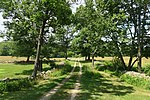Milford, New Hampshire
1794 establishments in New HampshireMilford, New HampshirePopulated places established in 1794Populated places on the Underground RailroadTowns in Hillsborough County, New Hampshire ... and 2 more
Towns in New HampshireUse mdy dates from July 2023

Milford is a town in Hillsborough County, New Hampshire, United States, on the Souhegan River. The population was 16,131 at the 2020 census, up from 15,115 at the 2010 census. It is the retail and manufacturing center of a multi-town area known informally as the Souhegan Valley. The town center, where 9,212 people lived at the 2020 census, is defined as the Milford census-designated place (CDP), and is located at the junction of New Hampshire routes 13 and 101A.
Excerpt from the Wikipedia article Milford, New Hampshire (License: CC BY-SA 3.0, Authors, Images).Milford, New Hampshire
South Street,
Geographical coordinates (GPS) Address Nearby Places Show on map
Geographical coordinates (GPS)
| Latitude | Longitude |
|---|---|
| N 42.835277777778 ° | E -71.648888888889 ° |
Address
South Street 12
03055
New Hampshire, United States
Open on Google Maps








